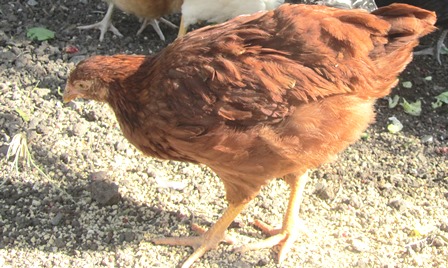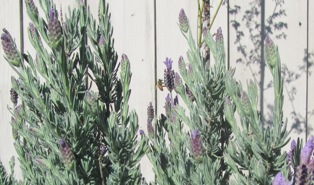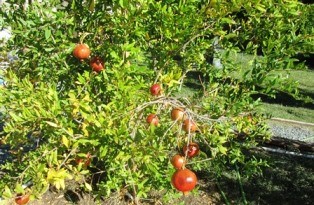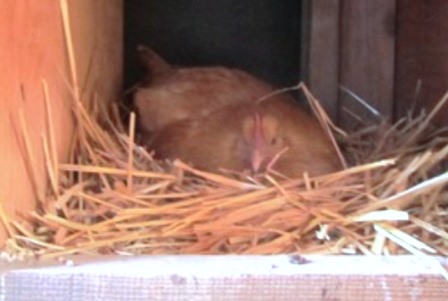Archive for September, 2014
Help–There’s a Chicken on My Back
Collecting eggs, I bent over into the chicken house. Suddenly, a large chicken land on my back and start talking to me in her chicken language. I immediately knew it was my Rhode Island Red. She follows me everywhere.
It would have made a cute picture, but here’s the thing: you don’t want chickens tarrying too long in one place because they are famous for frequent and abundant droppings.
The Rhody is the most personable chicken in my flock and the one I handled the least when I cared for the flock of baby chicks in a tub in my kitchen. However, the chicken I handled the most from my tub of baby chicks was the yellow Buff Orpington, and today she’s difficult with the other hens and its also the first to have gone broody.
As I do chores around the farmette, the Rhody keeps me company. When I go inside to work in my office on my writing projects, she often hangs out under my office window, clucking or making an number of various chicken sounds. She also responds to my voice when I call out her. If I had it to do over again, I’d have a whole flock of Rhode Island Reds, just for the personality.
Big, Blonde Buff-O Goes on the Attack
The yellow-colored Buff Orpington hen seemed so cute when she was all down and a day old.
But six months have passed, the Buff-O has feathered out and gone broody. Today, she showed me a nasty-tempered, cranky hen, with ruffled feathers who will stop at nothing to hatch the clutch of eggs she’s sitting on.
The problem is that some of those eggs in the nesting box aren’t hers, and they’re all unfertilized since we have no rooster.
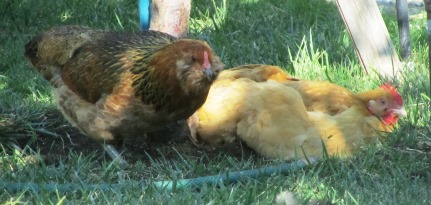
From left to right: Furry Face, the Ameracuana, and Buff-O, the Buff Orpington, when they used to sun themselves together
Buff-O has been sitting on the clutch of eggs for almost three weeks now, barely leaving to eat or drink. But today, she exited the hen house to take dirt bath–that’s how chickens clean themselves. Toss on the dirt, roll in it, then get up and shake like a dog, flinging the dirt in all directions as far as possible.
Before the fight started, all nine of my hens were foraging on our property, except for Buff-O and the shy Ameracauna with the furry face. The latter was in the chicken run, scratching the dirt, minding her own business.
I saw Buff-O walk over and lunge at Furry Face in attack mode. She used her beak to viciously peck Furry Face’s neck and her clawed toes to tear at the poor shy chicken’s back. She seemed more rooster than hen.
I ran for the hose and separated the two with a spray of water. Then, with both out of chicken run and into the yard, I gathered up all those unfertile, soon-to-be-rotten eggs that Buff-O has been trying in vain to hatch, and headed toward the garbage can.
But apparently, tossing those eggs changed nothing. Buff-O is back in the hen house on the nest–albeit, a different nesting box than before. But the straw in the original nesting box is still warm. It’s being occupied by Furry Face. Go figure!
Drawing into Your Life Your Heart’s Desires
If you could manifest anything in your life, what would it be? Could you doodle an image of that desire? Form the intention of having your dream come true? Could you take some small action every day to reinforce your intention to manifest that dream?
If the answers are yes, you’ll be happy to know that your deepest desires are within reach. The ancient, universal law of attraction simply conveys that like attracts like. Our thoughts bring to us what we think about most. When we supercharge our thoughts with strong emotional feelings, our thoughts set up an attraction to draw to us the thing about which we are thinking/feeling.
The publication date for my newest nonfiction book is the day after New Years Day 2015. The idea for the book is to inspire readers to use doodling as a way of turning desire into the intention of having what their hearts desire. See, http://www.amazon.com/Doodle-Your-Destiny-Dreams-Reality/dp/1440586519
You are both artist and architect of your own life. Through your thoughts, you are already attracting good and bad into your life. We all dream about having something–an object, a coterie of friends or a soul mate, or optimal circumstances (better job, better pay, better ___________fill in the blank.) You absolutely can create more of what you desire and find meaningful and less of what you don’t want and find stressful if you use conscious thinking, intention, and action.
The Buddha said, “All that we are is the result of what we have thought: it is founded on our thoughts and made up of our thoughts.” Change your thoughts, change your life.
Even in the Buddha’s lifetime, people had doubts, fears, worries. Then as now, people obsess about the past or worry about the future. But how much better life will be if you stop that that kind of thinking in order to focus on the present in a positive way. Why? Because your thoughts today will manifest your tomorrow.
Doodling is something nearly everyone can do. It is a fun way to help you clarify what exactly your dreams are. Doodling a dream can inspire you. The prompts in the book will help you form the intention to attract the desired object, person, or circumstance into full expression in your life.
I challenge you to change your life in 2015. Pick up a copy and start manifesting your dreams and achieving those New Year’s resolutions. Doodle Your Destiny, Draw Your Dreams into Reality (Adams Media, Jan. 2015) is available online from Amazon.com and other online and brick-and-mortar bookstores.
The Bee Garden Favorites
I spent Sunday building a rock circle around the circumference of our towering elm tree. I want to conserve water around the base of the tree and to also grow more plants for my bees to have abundant food.
We had a pile of river rock donated to us, so I thought it might look nice to create a wide circle, maybe three feet high around the tree like a watering basin/retaining wall, using the rock.
Inside the circle, I transplanted some yarrow and white geranium. Already, there are white roses that boom all summer long under the tree.
But bees like nectar-rich plants with pollen, so I’ve put together a list. Over the next week, I’ll add some of these in my new bed beneath the elm. This is a partial list of plants bees love.
- Rosemary
- Lavender
- Russian sage
- Basil (African blue)
- Honeywort
- Mexican Sunflower
- Borage
- Cerinthe
- Greek oregano
- Sweet marjoram
- Purple coneflower (echinacea)
- California poppies
- Lupine
- yarrow
- sunflowers
Eucalyptus on the property behind our farmette is not yet covered with fall bloom. The bees love that bloom but now they make do with the star thistle on the brown hillsides and by foraging on the French perfume lavender and the Spanish variety in my garden.
Of late, I’ve discovered the honeybees foraging on the sweet nectar at my hummingbird feeders, so I worry about them getting enough food. The drought has sapped everything. At any rate, I’ll hold off taking honey this fall, leaving it in the hives for the bees. They’ll need food to get through the rainy season.
To-Do List of Chores for the Fall Garden
From my office widow, I look out over what once was a lush and thriving garden. Not so today.
I can hardly bear to gaze upon the sorrowful, dried tomato vines that for me have come to symbolize the severity of the extreme drought on California gardens.
Now that fall will soon arrive, I’ll toss onto the compost pile those vines along with others from pumpkins and hard-shelled squash.
So with the garden cleared, I’m thinking ahead to next year, ever hopeful we’ll get rain rather than a repeat of dry conditions like this past year.
To ensure the viability of our fruit trees, citrus trees, and various berries through the fall and winter, there is a spray regimen to be initiated. I’ll add it to my long list of chores that will need to be done.
MY FALL CHECKLIST FOR THE GARDEN
Turn the soil, add amendments like compost to hold in the water.
Prepare new beds.
Build cold frames and 4- x 6- foot boxes for new raised beds.
Cut the canes of blackberries (berries only set up on two-year-old canes that won’t again produce; cut to ensure new fruiting canes will take their place).
Prune away the spent floricanes of red raspberries, once they’ve produced fruit.
Clean up around the bases of all trees and evergreen plants; add mulch.
Also remove all leaves at the base of all fruit trees and dispose.
Remove rose leaves after blooming season, cut canes to 18 inches, and spray for diseases and pests.
Stake young trees so they’ll survive windy winters, growing straight and tall.
Treat the trees with an organic spray (one containing copper and protector oil) to prevent fungal disease and pests.
Get out the frost cloth in readiness to cover tender citrus trees.
Prune back the hydrangeas.
Plant fall bulbs for spring flowering.
Hypoallergenic Label for Dogs Might Be Misleading
Finding a dog that won’t cause wheezing and sneezing sounds like the perfect solution for families with allergies. But apparently the notion that some breeds–like poodles, labradoodles, terriers, shi tzus, or short- haired dogs–are hypoallergenic isn’t quite the case.
Allergic rhinitis is a common malady that affects 600 million people worldwide (200 million have asthma alongside the rhinitis). Pet allergies bear a significant burden as a common trigger for allergic rhinitis. See http://www.ncbi.nlm.nih.gov/pubmed/20031002
In an article from 2013 in the San Francisco Chronicle, author Kathryn Roethel cited a study by scientists in Detroit, who conducted research involving 173 single-dog homes. See, http://www.kathrynroethel.com/mythbusters/hypoallergenic-dogs-not-allergy-free-study-says
The researchers vacuumed floors of bedrooms in the Detroit area homes. Their goal was to find samples of a protein in pet saliva that caused human allergies to dogs, namely, canis familiaris 1. That allergen was found in 163 of the 173 homes the researchers tested. And dogs (labeled hypoallergenic), according to Roethel “averaged the same amount of the protein as non hypoallergenic dogs.”
Pet owners could reduce the amount of the allergen canis familiaris 1 by having tile and wood floors (which showed slightly less of the allergen in the study) than other floor materials such as carpet.
Also, dog owners could limit levels of the allergen by limiting the rooms that their dog was allowed in.
Keeping dogs outside did not eliminate the presence of canis familiaris 1, although indoor levels could be reduced.
An different study by the same research team indicated the presence of “canis familiaris 1 in approximately half of homes without dogs,” noted author Roethel, “possibly because dogs had lived there in the past.” To read the study, see http://1.usa.gov/1b7F5B4.
The solution is not to get rid of the family dog, but to find ways to reduce exposure to the allergen, canis familiaris 1. Talk with your allergist or family physician about options. And if you are thinking about becoming a dog owner, be aware that the hypoallergenic label might have little to no relevance.
A Broody Hen, A Clutch of Eggs, and No Rooster
My little yellow Buff Orpington {as yet unnamed) has gone broody. I didn’t know this behavior could happen so early in her young life. At 20 weeks, she’s only just started laying eggs. Now all she wants to do is sit on them.
Like an expectant mother, she contentedly sits, apparently anticipating the arrival of her chicklets (in 21 days). I don’t have the heart to tell her that she needed a rendezvous with a rooster to get eggs that will hatch. And, in case she hasn’t noticed, we don’t have a rooster.
She’s become a fixture on the nesting box, forcing the other chickens to lay their eggs in the other two. Buff O. sits on the eggs (who knows how many are under her) with a glazed look in her eyes. If I go near her nesting box, she puffs up and ruffles her feathers like an attack chicken.
She must leave the nest to eat, drink, and poop . . . . but I haven’t witnessed it, so I have put containers of food and water near the nest. I don’t want her losing weight or getting sick during her sit-in.
At first, sensing that she was behaving strangely and fearful that something be wrong with her, I began searching the Internet. Apparently some breeds like Silkies, and Cochins have a tendency to go broody. And, they can go broody more than once during the year. See, http://blog.mypetchicken.com/2012/02/01/what-is-a-broody-hen.
Apparently, dictated by their biology, laying hens decide to sit on a clutch of eggs, even rolling other chickens’ eggs under them if there aren’t enough. The laying hen will rotate her body to redirect heat evenly over the eggs or pluck out her own chest feathers to create more warmth and moisture for the eggs. In the case of my hen, I’m trying to imagine a bare-chested chicken sitting on a clutch of eggs that will never hatch.
Broody hens will even talk to the eggs (and the little chicks growing inside). It’s mommy business they are attending to. However, once a hen has gone broody, she will stop laying. And as for the mommy business, I have no idea how my Buff Orpington will figure out that those eggs she’s so carefully guarding . . . well, they’re just eggs.
If It’s Good Enough for Bill Gates, I Might Try It, Too
On Sunday mornings on our farmette, we almost always have potatoes, assorted cheeses and fresh fruit, along with homemade bread, honey, and a jar of apricot or strawberry jam that I’ve put up during jam season. But organic eggs from my free-range heritage chickens takes center stage, scrambled or poached (my favorite, a la Jacques Pépin and Julia Child), or cooked in an omelet with fresh herbs.
People who can’t eat poached, scrambled, or omelet eggs because of cholesterol concerns or egg allergies often make do without eggs or indulge their omelet craving with egg substitutes. But what about egg-free cookie dough or mayonnaise?
Enter Eco-food innovator, Hampton Creek Foods. The company’s biochemical scientists at work at the three-year-old, San Francisco-based company have come up with an egg substitute that is plant-based. It has already found a perfect plant-based recipe for egg-free mayonnaise and cookie dough.
With its egg substitute, Beyond Eggs, and other products, the company seeks to crack open an industry that produces 1.1 trillion eggs annually.
According to Katie Fehrenbacher, writing last year for Gigaom, Hampton Creek Foods CEO Josh Tetrik says “the food industry is broken.” See, http://gigaom.com/2013/09/11/hampton-creek-now-selling-plant-based-eggs-at-whole-foods-in-california/
Hampton Creek touts its plant-based, egg-free formulas as cheaper, healthier, and more humane. With its emphasis on food technology, Hampton Creek has attracted interest and funding from Silicon Valley venture capitalists and the world’s super-wealthy billionaire Bill Gates and Li Ka-shing, Asia’s richest man.
Earlier this year, Forbes writer Ryan Mac discussed Hampton Creek’s food technology venture that has attracted the interest of Yahoo co-founder Jerry Wang and Li Ka-shing. See, http://www.forbes.com/sites/ryanmac/2014/02/17/egg-replacing-startup-hampton-creek-foods-raises-23-million-from-asias-richest-man-and-yahoo-cofounder-jerry-yang/
In California, foodies can find Hampton Creek’s Beyond Eggs at Whole Foods stores. Those who love the real thing can buy eggs labeled as organic, produced by pastured free-range flocks.
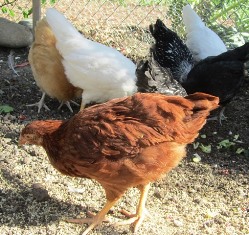
A Rhode Island Red forages with a Buff Orpington, two White Leghorns, a Black Sex Link, and two Silver-laced Wyandottes
According to tests conducted by Mother Earth News,the eggs from free-range pastured chickens have more beta carotine, vitamin A, vitamin E, and Omega-3 fatty acids with less cholesterol and less saturated fat than most store-bought eggs from chickens that weren’t pastured. See, http://www.motherearthnews.com/real-food/free-range-eggs-zmaz07onzgoe.aspx#axzz3CB01GPlj
Sunday mornings on the farmette wouldn’t be the same without fresh eggs from the hen house, but if Bill Gates likes Hampton Creek Foods’ products, I might just give them a try. Still, I’m having a hard time imagining how the taste of an egg substitute from a yellow-pea and canola concoction could rival an organic egg.
 Facebook
Facebook Goodreads
Goodreads LinkedIn
LinkedIn Meera Lester
Meera Lester Twitter
Twitter






